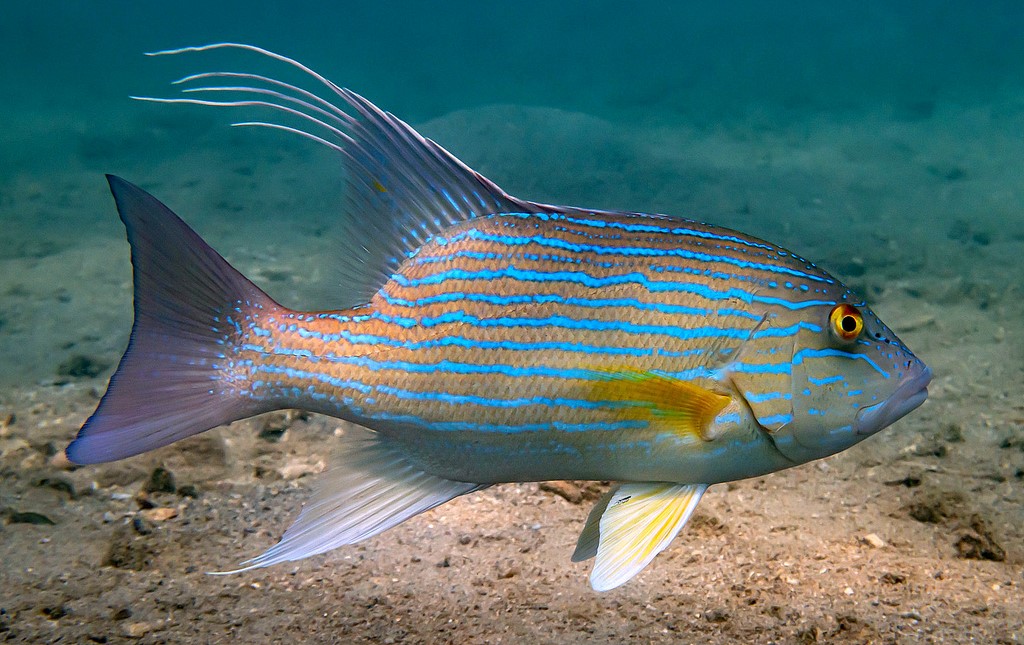SYMPHORUS NEMATOPHORUS - (BLEEKER, 1860)
Picture courtesy of: Pauline Fey
Actinopterygii (Gigaclass) > Actinopteri (Class) > Teleostei (Subclass) > Acanthuriformes (Order) > Lutjanidae (Family) > Paradicichthyinae (Subfamily) > Symphorus (Genus)
Vivaneau diable, Lutjan à filament, Barbillon, Kineserfisk, Chinaman, Chinaman Cod, Chinaman fish, Chinaman snapper, Chinaman-fish, Chinamanfish, Galloper, Snapper, Thread-finned sea perch, Pargo diablo, Itohiki-fuedai, イトヒキフエダイ, 丝条长鳍笛鲷, 曳絲笛鯛, عصموديّ إبليس,
Synonymes
Glabrilutjanus marshalli (Whitley, 1932)
Glabrilutjanus nematophorus (Bleeker, 1860)
Lutianus nematophorus (Bleeker, 1860)
Lutjanus nematophorus (Bleeker, 1860)
Mesoprion nematophorus (Bleeker, 1860)
Paradicichthys venenatus (Whitley, 1930)
Symphorus taenilatus (Günther, 1872)
Symphorus taeniolatus (Günther, 1872)
Symporichthys nematophorus (Bleeker, 1860)
------------------------
Description
Dorsal spines (total): 10; Dorsal soft rays (total): 15-16; Anal spines: 3; Anal soft rays: 9; Pectoral fin rays: 16; Total gill rakers on first arch: 16-19; Body depth: 2.6-2.8 in SL. Soft portions of dorsal and anal fins moderately elevated, the anterior soft rays of juveniles forming several thread-like filaments. A deep groove between eye and nostrils. Max. length: 80.0 cm TL, common length: 35.0 cm TL. Max. published weight: 13.2 kg. Depth range: 10 - 100 m, usually: 10 - 50 m.
Color
Juveniles are pale orange to brownish, with irregular bluish stripes and markings on the head and sides, and several long filamentous dorsal-fin rays.
Adults large greyish-brown to reddish fish with often with broad irregular pale and dark bars on the sides.
Etymology
Symphorus: from Greek, syn, symphysis = grown together + from Greek, physis = growth body form + from Greek, oura = tail.
nematophorus: from Latin nēmato-, and from Greek nēma, nēmat- = thread + from Greek, phoros = a combining form meaning “bearer of,” “thing or part bearing”. These fishes are known ciguatoxin carrier and therefore cannot be eaten.
Original description: Mesoprion nematophorus Bleeker, 1860 - Type locality: Badjoa, Sulawesi, Indonesia.
Distribution
Southeastern Indian Ocean, western Pacific: Indonesia, east to Philippines and Vanuatu, north to Ryukyu Islands (Japan), south to northern Australia and New Caledonia.
Biology
Adults inhabit coral reefs, from shallow water to depths. They occur singly. They feed mainly on fishes. Frequently ciguatoxic in certain areas. Sold in Hong Kong live fish markets. It causes ciguatera poisoning in some areas. Banned for sale in Australia.
Last update: 11, May 2024
